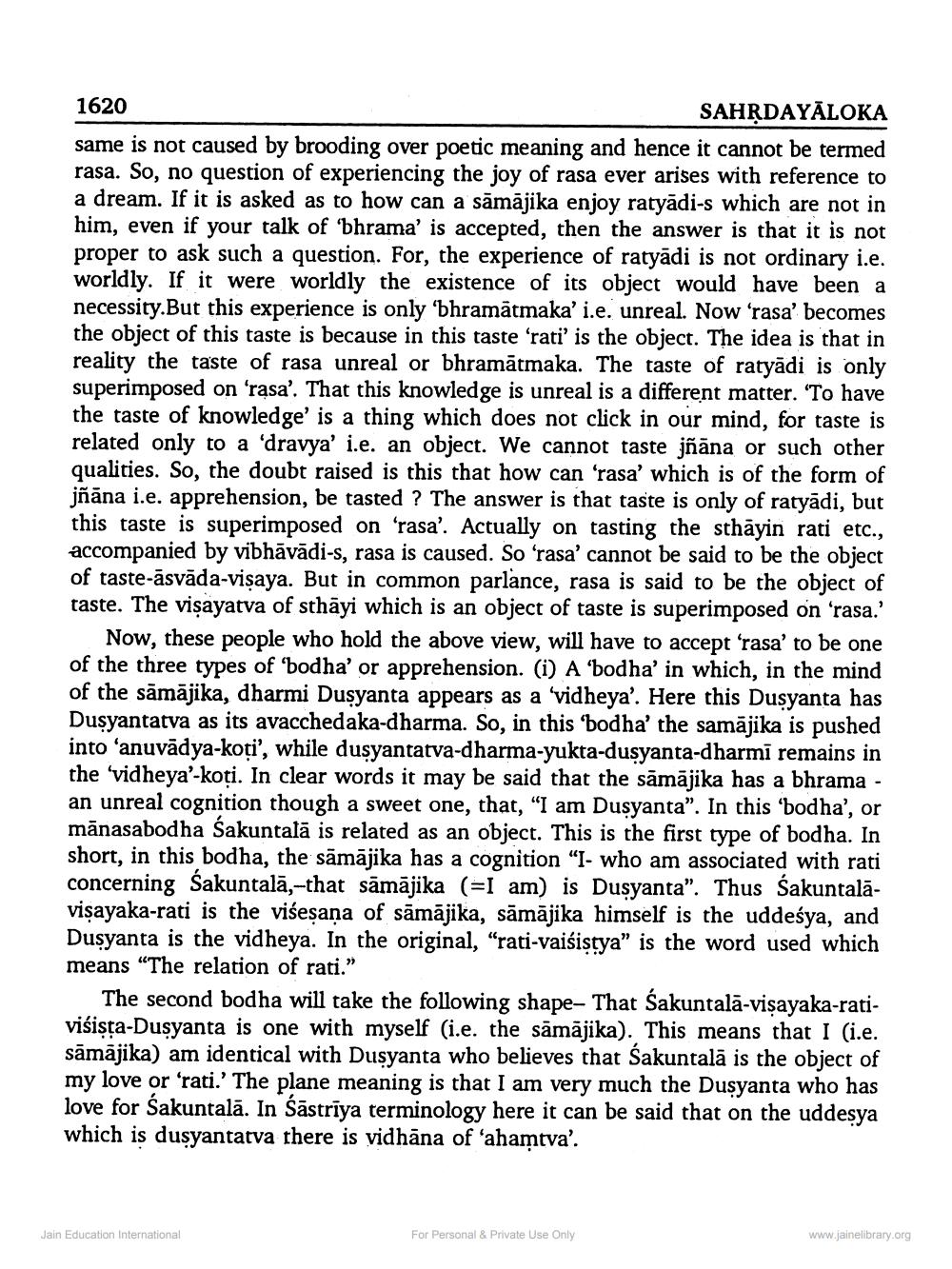________________
1620
SAHRDAYĀLOKA same is not caused by brooding over poetic meaning and hence it cannot be termed rasa. So, no question of experiencing the joy of rasa ever arises with reference to a dream. If it is asked as to how can a sāmājika enjoy ratyādi-s which are not in him, even if your talk of bhrama' is accepted, then the answer is that it is not proper to ask such a question. For, the experience of ratyādi is not ordinary i.e. worldly. If it were worldly the existence of its object would have been a necessity.But this experience is only 'bhramātmaka' i.e. unreal. Now 'rasa' becomes the object of this taste is because in this taste ‘rati' is the object. The idea is that in reality the taste of rasa unreal or bhramātmaka. The taste of ratyādi is only superimposed on 'rasa'. That this knowledge is unreal is a different matter. To have the taste of knowledge' is a thing which does not click in our mind, for taste is related only to a 'dravya' i.e. an object. We cannot taste jñāna or such other qualities. So, the doubt raised is this that how can 'rasa' which is of the form of jñāna i.e. apprehension, be tasted ? The answer is that taste is only of ratyādi, but this taste is superimposed on 'rasa'. Actually on tasting the sthāyin rati etc., accompanied by vibhāvādi-s, rasa is caused. So 'rasa' cannot be said to be the object of taste-āsvāda-visaya. But in common parlance, rasa is said to be the object of taste. The vişayatva of sthāyi which is an object of taste is superimposed on 'rasa.'
Now, these people who hold the above view, will have to accept 'rasa' to be one of the three types of 'bodha' or apprehension. (i) A bodha' in which, in the mind of the sāmājika, dharmi Dusyanta appears as a 'vidheya'. Here this Dusyanta has Dusyantatva as its avacchedaka-dharma. So, in this bodha' the samājika is pushed into 'anuvādya-koti', while dusyantarva-dharma-yukta-dusyanta-dharmī remains in the 'vidheya'-koţi. In clear words it may be said that the sāmājika has a bhrama - an unreal cognition though a sweet one, that, “I am Dusyanta”. In this 'bodha', or mānasabodha Śakuntalā is related as an object. This is the first type of bodha. In short, in this bodha, the sāmājika has a cognition "I- who am associated with ra concerning Sakuntalā,-that sämājika (=I am) is Dusyanta". Thus Sakuntalāvisayaka-rati is the viśeşana of sāmājika, sāmājika himself is the uddeśya, and Dusyanta is the vidheya. In the original, "rati-vaisistya" is the word used which means “The relation of rati."
The second bodha will take the following shape- That Śakuntalā-visayaka-rativiśista-Dusyanta is one with myself (i.e. the sāmājika). This means that I (i.e. sāmājika) am identical with Dusyanta who believes that Sakuntalā is the object of my love or ‘rati.' The plane meaning is that I am very much the Dusyanta who has love for Sakuntalā. In Sāstriya terminology here it can be said that on the uddesya which is dusyantarva there is vidhāna of 'ahamtva'.
Jain Education International
For Personal & Private Use Only
www.jainelibrary.org




